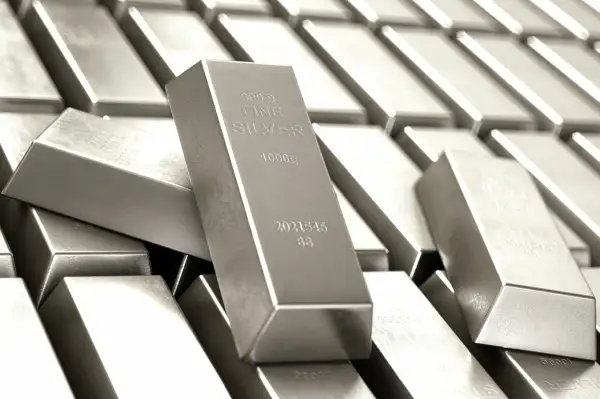What Is a Silver IRA?
Money is not a client of any investment adviser featured on this page. The information provided on this page is for educational purposes only and is not intended as investment advice. Money does not offer advisory services.

Investing in precious metals is a popular strategy for diversifying investment portfolios and safeguarding against economic uncertainties. While gold is often the first metal that comes to mind, silver offers its own advantages. One way to invest in silver is through an individual retirement account (IRA).
It’s important to note that silver IRAs are the same thing as gold IRAs or precious metals IRAs. These financial instruments allow you to hold precious metal-backed assets in a retirement account. Most of the best gold IRA companies have gold, silver, platinum and palladium available for investment. Investing in precious metals IRA does not make sense for many investors. You’ll want to heavily weigh the downsides to saving for retirement this way, as well as check on the reputability of the company you work with.
Read on to learn more about the intricacies of silver and precious metals IRAs, the various types available and other insights into the potential risks and rewards of investing in silver.
Table of Contents
- Silver IRAs explained
- How does a silver IRA work?
- Different types of silver IRAs
- Benefits of investing in a silver IRA
- Disadvantages of investing in a silver IRA
- How to invest in a silver IRA
- Important things to consider before investing in a silver IRA
- Silver IRA FAQs
- Summary of what is a silver IRA
Silver IRAs explained
A silver IRA, also known as a precious metals IRA, is a specialized type of individual retirement account that allows investors to include physical silver bullion — and other metals — in their retirement portfolio. Most companies offer both gold and silver for investment as well as platinum and palladium. Metals must satisfy strict purity and weight standards set forth by IRS rules.
Including silver in a precious metals IRA provides investors an additional avenue to diversify their holdings and benefit from the long-term value appreciation of silver. According to The Silver Institute, investment demand for silver increased in 2022, with a strong surge in retail investment in coins and bars.
How does a silver IRA work?
A silver IRA works similarly to a traditional IRA, but instead of investing in stocks, bonds or mutual funds, it allows you to invest in physical precious metals, like silver bullion. Precious metals IRAs are self-directed IRAs, meaning the investor chooses the specific IRA investments to hold within the account.
Your precious metals IRA will have a custodian responsible for holding and managing the physical assets in an approved depository. You can make contributions to the account, which will be used to purchase physical silver bullion or other metals, like physical gold. The value of the IRA is determined by the market value of the metal held in the account.
One important thing to note is that there are specific IRS regulations for investing in a silver IRA. For example, the silver held in the account must meet certain purity standards (99.9%). You must also adhere to an annual contribution limit to be considered IRS-approved. Be sure to work with a reputable silver IRA provider who can help navigate these guidelines and does not pressure investors with fear-mongering tactics, as some precious metals IRA companies do.
You can start withdrawing from your IRA without facing a penalty once you reach age 59 ½, and you will have minimum withdrawal requirements each year once you reach age 73. You can either liquidate your silver or have the physical precious metals investments shipped to you.
Silver IRAs offer tax advantages similar to traditional IRAs, such as the ability to defer taxes on contributions and earnings until retirement. However, the tax treatment of physical silver differs from other assets held in traditional IRAs. It's crucial to understand the tax implications of investing in a silver IRA and consult with a tax professional before making any investment decisions.
Different types of silver IRAs
Three types of silver and precious metals IRAs exist — traditional, Roth and Simplified Employee Pension (SEP) IRAs. Here is more information about the different options:
- The Traditional IRA allows investors to make tax-deductible contributions, but they pay taxes upon withdrawal in retirement.
- The Roth IRA allows investors to contribute after-tax dollars, but withdrawals in retirement are tax-free.
- For self-employed individuals, the SEP IRA offers a way to save for retirement while taking advantage of tax-deductible contributions.
It's important to note that not all IRA custodians offer all types of precious metals IRAs. Research the offerings of multiple companies before choosing one.
Benefits of investing in a silver IRA
Investing in a silver IRA may provide a hedge against inflation and market volatility. It can help diversify your investment portfolio and provide tax benefits.
Silver has long been considered a safe-haven asset, as it tends to retain its value even during economic downturns. Therefore, adding silver to your retirement portfolio may help protect your savings against market volatility and inflation. That said, compared to the gold market, the silver market is relatively smaller and less liquid. As a result of its lower trading volume, silver is more prone to volatility and may exhibit more significant price fluctuations than gold.
Another benefit of investing in a silver or precious metals IRA is the tax benefits. Contributions made to traditional IRAs may be tax-deductible — meaning the amount you contribute reduces your taxable income — and earnings are tax-deferred until you start withdrawing. Meanwhile, with Roth silver IRAs, withdrawals made after age 59 ½ are tax-free, but you pay taxes on contributions.
Disadvantages of investing in a silver IRA
Silver IRAs do not make sense for every investor, and putting your retirement savings into one is not a decision you should make lightly, as there are some drawbacks to silver IRAs. First off, silver doesn’t generate any income in the form of dividends or interest. A precious metals IRA can also be one of the more expensive options for investing in silver because of its fees (silver IRA companies often charge startup and maintenance fees). You’ll likely have to pay a yearly fee for storage and insurance of your physical precious metals.
Additionally, if you want to liquidate your silver in the future, you may have to sell it for less than it’s worth. Your IRA company may have a buyback program, or you may be able to sell it to a metal shop (though the latter option might offer you a lower price).
How to invest in a silver IRA
To open a silver IRA, you must have earned taxable income or be the spouse of someone who has. Roth IRAs have income limits, and SEP IRAs are for self-employed individuals. You must also find a reputable precious metals IRA company to open an account. If your goal is to invest in silver, make sure the company you choose has the silver options you want, especially since gold is typically the predominant metal offered.
Once you have chosen a company, the account setup is relatively straightforward but will vary depending on the company. You will need to provide personal information and select the type of IRA you want to open. Then, you must fund the account by transferring funds from an existing 401(k) or IRA, or by making a contribution. The company will then purchase physical silver bullion (or other metals) on your behalf and store it in a secure facility.
Silver IRA requirements
It's important to note that the IRS has specific requirements for the type of silver that can be held in a silver IRA. Only certain types of silver — such as the American Silver Eagle, Canadian Maple Leaf and Australian Silver Kangaroo, for example — are eligible for inclusion in a silver IRA.
Also, remember that you cannot contribute more than the annual contribution limit to your silver IRA. For 2023, the contribution limit is $6,500, and $7,500 if you are 50 or older and want to make “catch-up contributions.”
Important things to consider before investing in a silver IRA
Before investing in a silver IRA, there are several important things to think about. First, consider the volatility of the silver market. Silver prices can fluctuate rapidly and dramatically, so it's essential to have a long-term investment strategy and be prepared for potential fluctuations. It may also be a good idea to consult a financial advisor to determine if silver is the right choice for your overall investment portfolio.
Additionally, it's essential to research the various types of silver IRA companies available. Consider each company's setup fees, annual fees and minimum investment requirements. Precious metals IRA accounts typically have more fees than normal IRAs due to the added cost of purchasing, storing and insuring the physical metal. Take a close look at storage fees and options as well as security measures offered by each company to ensure the safety of your investment.
In addition to these considerations, it's crucial to evaluate the reputation of the silver IRA provider. Look for a company with a proven history of providing reliable service, transparent and competitive pricing and timely customer support.
Silver IRA FAQs
How do I know if a silver IRA company is reliable?
You can check if the company is registered with the appropriate government agencies, such as the Securities and Exchange Commission (SEC) and the Financial Industry Regulatory Authority (FINRA). You can also seek recommendations from financial experts or friends who have invested in precious metals IRAs.
Who is considered eligible for a silver IRA?
Additionally, you must have a valid Social Security number or an Individual Taxpayer Identification Number (ITIN). Both U.S. citizens and non-U.S. citizens that legally work in the country can open an IRA.
How long does it take to open a silver IRA account?
To open an account, you must provide personal information, such as your name, address and Social Security number. You will also need to choose a custodian to hold and manage your investment. The custodian will provide you with the necessary forms to complete, and you will need to transfer funds from your existing retirement savings account or make a new contribution to fund your silver IRA. If you are transferring funds, the process can take several weeks to complete, depending on the speed of your custodian.
Summary of our guide to silver IRAs
Investing in a silver IRA allows individuals to diversify their investment portfolios and protect against economic uncertainties, but there are risks you should consider before making a decision. Silver IRAs fall under the category of precious metals IRAs, as do gold IRAs. Silver and gold IRAs are essentially the same thing; an IRA that allows you to invest in precious metals.
To start a silver IRA, investors must meet specific eligibility requirements, including having earned income or being the spouse of someone who does. When investing, it's essential to consider all potential benefits and disadvantages. Silver IRAs do not generate income like dividends or interest.
To open a silver or precious metals IRA account, investors must:
- Provide personal information
- Select a reputable custodian
- Fund the account through contributions or IRA rollovers from existing retirement accounts
- Understand the IRS rules and restrictions regarding the type of silver eligible for inclusion in a silver IRA
Considering the volatility of the silver market, it’s advisable to have a long-term investment strategy and consult with a financial advisor for retirement planning before making any investment choices. Researching the reputation of silver IRA companies, checking for legal and regulatory compliance and seeking recommendations can help identify reliable providers for safer investment practices that benefit your financial future.

